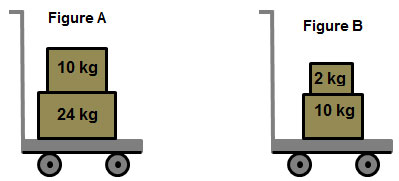
The first law of motion is often called the law of inertia. Have you ever been riding in a car that has come to a quick stop? What happened to your body? If you were not wearing your seat belt, your body probably moved forward. Inertia is the tendency of all objects to resist any change in motion. Inertia causes a moving object to stay in motion at the same velocity (speed and direction) unless a force acts on it to change its speed or direction. It also causes an object at rest to stay at rest.
What was the unbalanced force in this picture?
What happened to the man in the car when the car hit the wall?
When the car hit the wall (unbalanced force), the car stopped moving, but the man kept moving because of inertia. If the man had been wearing his seat belt, the seat belt would have acted as an unbalanced force on the man and changed his motion, keeping him in the car.
Let's say that you were asked to move the two stacks of boxes pictured below. The mass of each box is shown on the box. Which stack of boxes would be easier to push?

An object with a small mass has less inertia than an object with a large mass. So, it is easier to move or to change the motion of an object with a smaller mass.